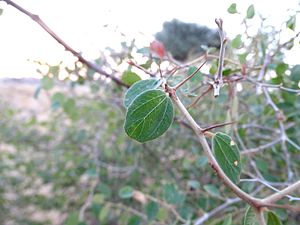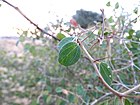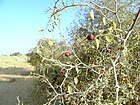Note: This is a project under development. The articles on this wiki are just being initiated and broadly incomplete. You can Help creating new pages.
Ziziphus nummularia - Balakapriya
Balakapriya or Ziziphus nummularia is a species of Ziziphus native to the Thar Desert of western India and southeastern Pakistan and south Iran. Common names are Mulluhannu, Bhu-kartaka, Zariab etc.
Uses
Parts Used
Chemical Composition
Green pala (Ziziphus nummularia) leaves had crude protein 14.25, ether extract 4.34, crude fibre 15.73, N-free extract 57.12, total carbohydrates 72.85, ash 8.56, Ca 2.43 and P 0.144% in dry matter (DM)[1]
Common names
| Language | Common name |
|---|---|
| Kannada | bale, bale-gida, bale-hannu |
| Hindi | amrit, kachkula |
| Malayalam | etavala, ettakkaya, kadalam |
| Tamil | ambanam, ampanam |
| Telugu | amritapany, amrytapani |
| Marathi | NA |
| Gujarathi | NA |
| Punjabi | NA |
| Kashmiri | NA |
| Sanskrit | alabu, ambusara, amsumatphala |
| English |
Habit
Identification
Leaf
| Kind | Shape | Feature |
|---|---|---|
| ovate | elliptic | oblique or rounded at base, serrate at margin, acute or obtuse at apex, 1-2.5 x 0.5-1.8 cm, glabrous or tomentose above, tomentose to white-wooly beneath, 3-nerved at base |
Flower
| Type | Size | Color and composition | Stamen | More information |
|---|---|---|---|---|
| unisexual | Flowers 4-5 mm across | 5 stamens | Stamens 0.8-1.2 mm long | Inflorescences axillary 10-20 flowered cymes, Flowering and Fruiting Time : September |
Fruit
| Type | Size | Mass | Appearance | Seeds | More information |
|---|---|---|---|---|---|
| short legume | seeds 1 or 2 compressed, black | glabrous | 12-20 seeds, Disc faintly 10-lobed. Ovary 2-loculed, Flowering and Fruiting Time : September | {{{5}}} | {{{6}}} |
Other features
List of Ayurvedic medicine in which the herb is used
- Vishatinduka Taila as root juice extract
Where to get the saplings
Mode of Propagation
How to plant/cultivate
Plants reach about 3 m height with 3.5 cm stem diameter in 2 years, in 4 years about 5 m height and 7 cm stem diameter. Flowering and fruiting is almost throughout the year, but in India there are usually two main flowering periods, one in the early monsoon and another in the late monsoon.[3]
Commonly seen growing in areas
Photo Gallery
References
External Links
- Ayurvedic Herbs known to be helpful to treat scabies
- Ayurvedic Herbs known to be helpful to treat skin diseases
- Herbs with Root used in medicine
- Herbs with Bark used in medicine
- Herbs with Leaves used in medicine
- Herbs with common name in Kannada
- Herbs with common name in Hindi
- Herbs with common name in Malayalam
- Herbs with common name in Tamil
- Herbs with common name in Telugu
- Herbs with common name in Sanskrit
- Habit - branched shrub
- Index of Plants which can be propagated by Seeds
- Index of Plants which can be propagated by Cuttings
- Herbs that are commonly seen in the region of dry regions of India
- Herbs that are commonly seen in the region of sea coast
- Herbs that are commonly seen in the region of dry zone in Sri Lanka
- Herbs




